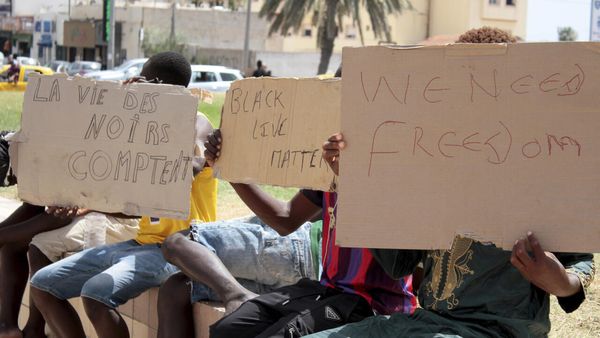
Across the United States, members of the “conservative” movement are engaging in an Orwellian assault on freedom of thought and the truth. Their tactics and strategies include banning books, targeting librarians and other educators for harassment and violence, and forcing both private and public schools (including universities and colleges) to change their curriculum to conform with “patriotic education," meaning a literal white-washing of American history in service to a right-wing and neofascist agenda.
Central to this Orwellian propaganda-indoctrination program is distorting if not outright lying about and erasing the real history of black and brown Americans, women, the LGBTQ community, and other marginalized people. This is not an abstract debate about public policy and education: it is a matter of power, life, death and the future of the United States. As political scientist Derefe Kimarley Chevannes warns in a new commentary essay at The Chicago Tribune, “Banning Black literature is not an abstraction. Its costs are counted in Black graves.”
The neofascists’ weaponization of public education is part of a global campaign to end pluralistic democracy as seen in countries such as Hungary, Poland, Argentina, and Putin’s Russia.
This movement is neither “grassroots” nor new. Right-wing forces have been working to end high-quality education in America as part of a much larger plan to end social democracy since at least the New Deal (attempts to suppress the real history of Black people have their origins decades and centuries earlier in chattel slavery and Jim Crow). As many journalists have documented, this supposedly grassroots movement for “parents rights” and “school choice” actually consists of a very well-funded network of interest groups, donors, ideologues and other malign right-wing elite actors.
Why are the Republican fascists, MAGA people, and other “conservatives” and members of the white right so obsessively focused on destroying and suppressing the real history of Black Americans?
White-on-black slavery and then Jim and Jane Crow apartheid were America’s native forms of fascism and racial authoritarianism. Over several centuries, reaching a crescendo in the 1950s and 1960s, the African-American civil rights movement and long Black freedom struggle tore down those systems of oppression in America (and then inspired similar movements by other marginalized peoples both here and around the world). In all, the African American civil rights movement is among history’s greatest examples of how everyday people can organize against overwhelming odds to resist tyranny and oppression and create a more democratic and humane society. Ultimately, the American neofascists and their allies want to deprive the American people of this knowledge as a way of creating a complaint public that will succumb to learned helplessness and a belief that resistance is futile.
Journalist Thomas Ricks is the author of multiple bestselling books, including Fiasco, which was a finalist for the Pulitzer Prize. Ricks was also a member of two Pulitzer Prize–winning teams at The Washington Post and The Wall Street Journal. His most recent book is “Waging a Good War: How the Civil Rights Movement Won Its Battles, 1954-1968.” Ricks’ first thriller, “Everyone Knows But You” will be published in June.
In this conversation, Ricks highlights the lessons to be learned from the African-American civil rights movement for how to defeat Trumpism, the Republican fascists, and the larger project by the white right to end the country’s multiracial pluralistic democracy.
Ricks explains how contrary to the widely believed myths about passive “non-violence”, the civil rights movement actually used military tactics and strategy in a highly sophisticated way (what he describes as “aggressive non-violence”) to defeat Jim and Jane Crow and force the country to better live up to its professed democratic ideals.
Towards the end of this conversation, Ricks reiterates how successful pro-democracy movements such as the civil rights movement require a great deal of personal sacrifice and hard work – lessons that participants in what will be a decades-long struggle to defeat American neofascism and the MAGA movement need to learn imminently.
This interview has been lightly edited for clarity and length:
How are you feeling given we are less than one year away from the election and all of the other challenges we are experiencing?
I feel kind of sick to my stomach. I actually have withdrawn from the news a bit—which is a big step for someone who was a reporter for more than two decades.
Jan. 6 was an attempt to end multiracial democracy. It was a repudiation and attack on the long Black freedom struggle and the great successes of the civil rights movement. Why do you believe that framing and context is not the dominant one for understanding Jan. 6?
Basically, a lot of people on the American right have given up on democracy, especially if it means that minorities hold some power.
The bigger the issue, the longer it takes for media and public discourse to be able to discuss it. We lack the vocabulary to help us talk about it. A war? They understand that. Global warming? Not so much. The long-term effects of the loss of caste privilege for white Americans? Even more difficult.
If the history of the Black freedom struggle were taught accurately to Americans, white and Black, it could be revolutionary. It would teach people how social change is really achieved: through impatient, persistent, aggressive work by disciplined, thoughtful people. Which may be why instead we are given a flat narrow story.
What are some lessons about struggle and resistance that apply today from the civil rights movement and Black Freedom Struggle both here in the U.S. and perhaps even globally in this fight against neofascism?
If there is one major point to take away from “Waging a Good War” is that achieving social progress requires disciplined, persistent, thoughtful organization. That means a lot of hard work.
The nonviolence of the civil rights movement had nothing to do with “passive resistance.” That term is simply inaccurate. It should not appear in any discussion of the Black freedom struggle. The civil rights movement used aggressive non-violence that sought to impose costs on the foe. Indeed, the city of Birmingham, Alabama, is still paying those costs. After World War II, it and Atlanta were about the same size. Now Atlanta is the capital of the Southeast, and Birmingham is far behind it in population and economy. A big part of the reason for this is how Birmingham responded to the civil rights campaign there in 1963.
Moreover, I don’t even think that “non-violence,” while emphasized, is taught accurately in schools. It was confrontational and aggressive. It was a physical struggle. It was important because it spoke a language the dominant caste did not and could not understand. The power structure knew violence and indeed was fluent in it. But it constantly was flummoxed by how to handle non-violent confrontation.
What are some of the military-strategic aspects of the civil rights movement as explained in the new book?
The civil rights movement began with strategy. Its members held long, almost endless discussions, especially SNCC. They spent time on it because it was important. If you get your strategy right, then tactics and training will follow.
The first question in making strategy should be: Who are we, and what are we trying to do? Diane Nash’s answer in Nashville before the student sit-ins there was brilliantly simple: We are people who will no longer tolerate segregation.
The next question is, OK, how do we put that thought into action? That is, what tactics will we use?
The answer was, We will not live with the dictates of segregation. We will go to segregated lunch counters and request service. We will get on segregated buses and not sit in the back.
The answer came back, They will fight you, they will even kill you.
Nash’s response was: We understand that. But that’s their problem, not ours. We’re not living that way anymore. And before we allow volunteers to get on a Freedom Ride bus, each one has to write a will and a last letter to parents, to ensure they understand what they are getting into.
That leads to the next step: Recruiting. That is, another military step. What kind of people do you need? The answer: You look for serious people who understand the risks and are willing to be trained.
Then you train them. Training is of course another military step. Before the sit-ins, Nash and others spent months in church basements preparing. They discussed the theory and practice of non-violence. Then they role-played, with one group playing sit-in students at a lunch counter, and another group pushing, shoving, spitting on them, even pouring coffee on them. Then the groups switched. So when they actually went to sit in, they were pretty ready for the white mobs that attacked them. When one student was spat on, he asked his attacker for a handkerchief, and the man actually began to reach for it.
Each sit-in group had leaders, who gave the signals and kept an eye on members who might be wavering. They also had white people as observers, taking notes on things like what time attacks occurred, when the police arrived, and what they did. This was useful especially in subsequent court testimony.
When they were jailed, they stayed organized, working as a group. They sang, they gave each other lectures, they held religious services, and they worked out. When they were freed in Nashville, the warden shook their hands and said they were the best prisoners he’d ever had.
Finally, they reviewed the campaign for lessons learned. What worked? What didn’t? How can we do better next time?
As a result of this disciplined approach, they were constantly ahead of their opposition, the white power structure of the South.
How did the leaders (and foot soldiers) of the civil rights movement measure success?
James Lawson, one of the important trainers in the Movement, emphasized that the important thing about a demonstration isn’t its size, it is its persistence. Can you do it again tomorrow?
When combined with non-violence, this meant, “I am not being passive. If you hit me on the head today, I won’t hit back. But I will be back tomorrow, with a friend. And the day after that, three of us will be there. We can take more than you can hand out.”
If your demonstration is big but doesn’t repeat itself, and doesn’t impose genuine costs on the foe, what has it done? Like good military leaders, they reviewed their operations and studied what worked and what didn’t.
Dr. King was a master strategist with a keen understanding of optics management and psychological operations. The popular myth making machine around King has so deradicalized his real message and literally whitewashed that aspect of his genius and courage.
I think King’s greatest move as a strategist was recognizing the strategic brilliance of James Bevel and Diane Nash. When those two were involved in his campaigns, he was more successful—Birmingham, Selma, the March to Montgomery. When they were absent, the campaigns didn’t go as well, as in Albany and St. Augustine. Then came Chicago. Bevel was involved, but that campaign flopped, for a variety of reasons. I think King and Bevel were exhausted and failed to recognize how different the situation was, both in terms of problems and scope, than Birmingham had been.
We are talking about a mass movement, but a mass movement is comprised of people. Who are some of the everyday people, perhaps lost to history, whose experiences moved you the most? There are so many in the book.
I really tried to focus on that level of the movement—the key thinkers, organizers and trainers who should be better known. James Bevel and Diane Nash, of course. But also, Amzie Moore, Medgar Evers—those guys were like members of the French Resistance, but their war lasted far, far longer. Bob Moses, Dave Dennis, the guys who led Freedom Summer. C.T. Vivian, and a score more. The moral insight of Septima Clark, who was fired as a schoolteacher in South Carolina for belonging to the NAACP, and went on to become a great trainer. The persistent tough courage of Fred Shuttlesworth. Fannie Lou Hamer deserves a movie of her own—what a presence. To me, these people are the equivalent of the great Civil War generals like Sherman.
What of the role of “white allies” in the civil rights movement?
They weren’t just allies, they were participants. On the front lines, a major role was that White America had shown, repeatedly, that it would not react to violence against Black Americans in the same way that it would to violence against whites, especially when those whites were privileged children of powerful bankers, lawyers, politicians and TV network executives. This was part of the strategy especially of the Freedom Rides and Freedom Summer.
A second major role of white allies was funding. Harry Belafonte brought in a lot of money from white members of the film industry in Hollywood. And predominantly white labor unions also provided cash at key moments.
The leaders and soldiers of the movement suffered emotional, psychological, and literal physical scars and long-term negative health consequences. That is a lesson about the blood, sweat, and tears and overall human cost of fighting for democracy against oppressive forces such as the MAGA movement and the larger right-wing both here in the US and around the world. Black folks, First Nations, Jewish brothers and sisters because of the Holocaust and antisemitism more broadly, and members of other communities with that historical and lived experience, know this cost. For many members of white America, especially the privileged and “middle class” – those “good white liberals” I mention often, what this struggle is going to cost and demand of them is something they are still in denial about — and I would suggest are not willing to pay.
A lot of people died young. Or burned out and disappeared. Combat has costs, both physical and mental.
One story I keep thinking about is something Dave Dennis encountered. He was one of the leaders of Freedom Summer. Later he went to law school in Michigan. He was checking out a book and recognized the clerk at the desk. He remembered she was a woman who had been detained by police officers in Vicksburg, Mississippi, who played Russian roulette with her head and a pistol. He asked someone about how this woman came to be a clerk in the law library and was told she was on a work-release program from a nearby mental hospital.
Your book will likely be banned in many parts of this country as part of the Republican fascists and MAGA movement’s Orwellian thought crime regime. I can’t imagine this book being taught in Florida or Texas – and that includes at public and perhaps even private colleges and universities. How does that feel?
I am not aware of it being banned anywhere. But if MAGA-world understood the book, they would hate it.
That said, what pains me most is people who actually sympathize with the civil rights movement and think they understand how it worked. Often, they really don’t. That’s why, with the paperback edition, we gave it a new subtitle, to make the point more explicit. People generally don’t understand how the civil rights movement worked and why it succeeded.
As the 2024 election approaches, what gives you the most hope and fear?
I get the most hope from the slow but steady decline of white supremacism in the United States. My guess is that at the beginning of the 20th century, it was supported by the vast majority of whites. By the mid-1960s, I would say it was perhaps 50 percent. Now it appears to me to be perhaps 20 to 25 percent.
My fear is that the Republican Party has given up on democracy.







